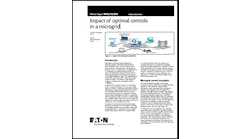Marshall Worth, senior project manager AI at PowerSecure, discusses artificial intelligence and a practical approach that microgrid customers can take today to achieve their energy goals of the future.
“Alexa, reduce my energy costs!”
With as fast as technology has progressed over the last decade, and with the promise of self-driving cars on the horizon and the electrification of everything, it’s only natural to question when this is all going to filter into our everyday, energy consuming lives. In this device-driven age, shouldn’t we already have the artificial intelligence (AI) capabilities to reduce our carbon footprint today and our energy bill tomorrow? Those of us who work in the energy industry are fortunate; we are naturally driven to innovate and build the future of energy. However, it’s a bit ambitious to think that the same machine that drives our car and controls our thermostat today can also manage on-site generating assets.
So where is it already?
The ability to use smart generating assets to bring both the right types of technologies and economic benefits together is key to helping your customers achieve their energy goals. With a microgrid, reliability and autonomy are of the highest priority, no matter the storm or business event. Microgrid developers who work with top tier hardware and software suppliers and provide seamless transitioning battery energy storage systems allow their customers’ operations to continue unabated. But your customer want more than just a technology provider; they want a microgrid partner who will analyze their local utility bills and help them achieve energy savings and renewable goals alike.
But why does any of that matter when we think about the energy of the future? Understanding microgrids is critical for today’s changing energy environment because with FERC Order 2222 microgrids have an incredible opportunity to participate in the fast-paced energy domain. Without a deep-rooted knowledge of the microgrid, it can be quite difficult to understand what higher level intelligence would even do to impact the energy industry! Unfortunately, we’re not yet at the point where the AI that drives your car also reduces your energy bill.
Practical, value driven solutions: artificial intelligence for the microgrid of the future
While we continue to innovate toward a future where artificial intelligence is fully integrated into microgrids, we need to take a practical approach and apply value driven solutions to help our customers achieve their energy goals today. First, we need to determine our customers’ needs and tailor a solution that works for them. This means we need to understand how energy rates combine with the various programs at our customers’ facilities. The rules and terms that determine how customers buy their electricity vary widely from utility to utility. Then, we need to carefully analyze the complex regulatory documents produced by utilities to decipher the various programs and rate structures our customers can take advantage of with their microgrid. Finally, we need to utilize software and optimization routines to achieve carbon reduction as well as energy savings. Today, we are fortunate to ride a tidal wave of development being done across all industries in artificial intelligence. The key is finding the right partner who understands how to utilize the plethora of linear and nonlinear programming techniques as well as exciting new developments in deep learning or even recurrent neural networks such as the long short-term memory network. A microgrid provider that employs such a diverse yet practical toolbox empowers customers to take control of their energy resources however they see fit.
As a leading provider and manager of microgrids in the industry, we know how to interface with generating assets and ensure reliability standards that exceed customer expectations. It’s not quite voice activated savings, but we believe this is an immediate and practical approach customers can take today to achieve their energy goals of the future.
Marshall Worth is senior project manager AI at PowerSecure.







